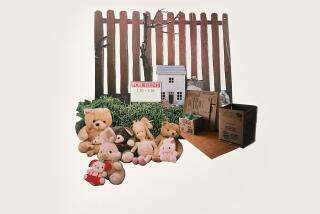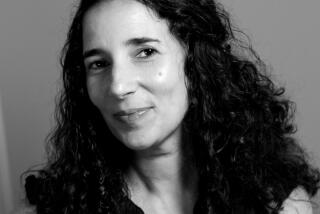“Little secret things like this . . .”
- Share via
CHATTANOOGA, Tenn. — In the fall of 1909, a young mountain woman, who lived with her husband and five children in a ramshackle cabin on Walden’s Ridge, Tenn., rose early to watch the sunrise and record these words in her journal:
”. . . the treetops, an Oriental fretwork of twigs against the clear, pale-blue westward sky, take on a warmer tone, as if dipped in a dye of red glory; the stain runs down and down the trunks, and the sun is up. A light wind springs with it, to rustle the thin white oak leaves that still cling.”
Emma Bell Miles’ childhood had prepared her, in some ways, for her life to come. It gave her an ability to compensate for hardships through an unquenchable joy in nature and in self-expression.
At the age of 3, Emma could read; at 7 she read “Pilgrim’s Progress,” and at 8, “Ben Hur” and Hawthorne’s “The Marble Faun.” When Emma was 13, her father offered her a $5 gold piece if she would keep a daily journal for one year. This task was not difficult for the sensitive child.
Almost a century later, there has been a rediscovery of the writings of Miles--with their colorful imagery, vitality, and surprising insight.
Last year, Kay Baker Gaston published a biography of Miles entitled “Emma Bell Miles.” (The journal excerpts quoted in this article came from Gaston’s book.) In 1983, the Walden’s Ridge Historical Assn. republished Miles’ own “Our Southern Birds,” which she also illustrated. And, in 1975, the University of Tennessee Press had republished “The Spirit of the Mountains”--an unsentimental, yet gently perceptive account of the customs, folklore, and day-to-day lives of the southern Appalachian mountain people-- written by Miles when she was 26.
During her lifetime, although she was recognized as a talented writer and artist, Miles lived in almost constant, desperate poverty, sewing “new” dresses for her daughters from hand-me-downs, and fixing suppers of “toast, tea, parsnips, and bean soup.”
The half-hours Miles spent at the typewriter or easel were not merely for pleasure. Unlike her friend Alice MacGowan, a fellow Tennessee writer, Miles depended upon her talents for the well-being of her family. She sold more than two dozen short stories and poems to Century, Harper’s Monthly, and Lippincott’s, popular magazines of her day. She composed lectures on nature and philosophy to give to social clubs in nearby Chattanooga. For two months in 1914, she wrote a weekly column called “Fountain Square Conversations” for the Chattanooga News. These were “conversations” among the birds that mingled at a well-known landmark.
Another source of income--one that Miles would have preferred not to draw upon--was the sale of hand-painted souvenir post cards or place cards to Chattanooga society people. These sold for 25 cents to $2, depending upon the generosity of the buyer.
For subjects she usually chose children (her own and neighbors’), wildflowers or simple mountain scenes. She excelled in watercolors of native birds, which she patiently followed through the woods in order to catch a glimpse of an underbreast or a nesting site.
Miles wrote from a dual perspective: She was a native of Indiana, well-educated in literature and art; yet she married a mountain man and reared her children among his people. Describing the spirit of gift-giving among mountaineers, she wrote:
“Send your neighbor in the mountains a present, and he will, if possible, return you something in the same basket. . . . The value of the gift has nothing to do with it. Perhaps what you gave him was costly--some store-bought article, and therefore doubly precious in his eyes. His return may be a fat shoat (young pig) or a newly killed ‘possum, or only a pumpkin or a cup of muscadines (grapes). However poor it may be, he is not ashamed of it. He has not looked at your gift so much as at the spirit of its offering, and he expects the same high-minded acceptance from you.”
She wrote, with similar gentle appreciation, of her own children, as follows:
“Now I renew, through them, the freshness of first impressions; I see through their eyes, feel the exquisite sentiment of first contact with the lovely things of life, with music and flowers, with light and joy.”
Emma’s own parents became missionary-teachers to the children of the rugged mountaineers. When she was 19, Emma met a young mountain man named George Frank Miles, who shared her intense love of nature. Three years later, against her parents’ wishes, they were married.
“He is a touchstone. All things are tested as rung against the perfect sincerity of his nature,” wrote Miles of her new husband.
However, his semi-illiteracy and low self-esteem, which prevented him from holding down anything but unskilled, intermittent jobs, would eventually put the full burden of earning enough to feed and clothe their family on her.
Miles consciously chose a life in the mountains over a life in the city. Among her possessions were a well-worn copy of Thoreau’s “Walden,” and a poem she wrote while attending art school in St. Louis. The second verse of “Homesick” reads, in part:
I am longing for the silence and the shadow,
I am dying for the starlight and the
dawn;
for the night wind crying free on the hills where I would be,
For the forest and the waters and
the sun.
In her journal, interspersed among the lyrical descriptions of nature, are accounts of her busy days. She wrote that she spent every possible half-hour at her huge, clumsy typewriter, given to her by Alice MacGowan. The remaining hours in her days and nights were spent caring for the many needs of her family and her “home”--sometimes a tent, sometimes a shack, and occasionally a house wallpapered with newspapers for warmth and decorated with wildflowers.
Jean Miles Catino, one of her twin daughters--”Jean and Judith” often mentioned in the journals--today lives with her husband on Walden’s Ridge. Unlike her mother, Catino has not spent her life there, and only recently returned from living in Florida for 25 years. Also an artist and naturalist, Catino remembers the happy hours spent with her mother in the woods.
“In the fall, we’d gather chestnuts and hickory nuts, in the summer blackberries and huckleberries. For play, we’d catch crawdads in the streams or dam the creeks to make swimming pools. We learned all about the plants and trees in the woods, and what they were used for (by the mountain peoples),” she said.
She remembers her mother killing a chicken for supper and, as she cut it up, grouping the children around the kitchen table for a lesson in physiology. “Children today don’t know a bee from a bunchflower (like a lily). They don’t know anything about nature, and I find that very sad,” Catino said.
Miles suffered increasingly from spells of extreme fatigue and pain. In 1914, she learned that she had tuberculosis. In February 1915, she made her first of two trips to the Pine Breeze Sanatorium, overlooking the Tennessee River. There she finally had uninterrupted quiet periods to rest, sketch, and write. There, too, she began writing and illustrating her last book, “Our Southern Birds.” She wrote it in pencil because she was not strong enough to type. Two weeks after its publication in March, 1919, Miles died at 39.
Miles’s frustrations seldom made her writings bitter. She once wrote: “Little secret things like this--the song of the mockingbird, the beauty of a single leaf--have made up so much of my life, and help me now through the days.”
More to Read
Sign up for our Book Club newsletter
Get the latest news, events and more from the Los Angeles Times Book Club, and help us get L.A. reading and talking.
You may occasionally receive promotional content from the Los Angeles Times.










